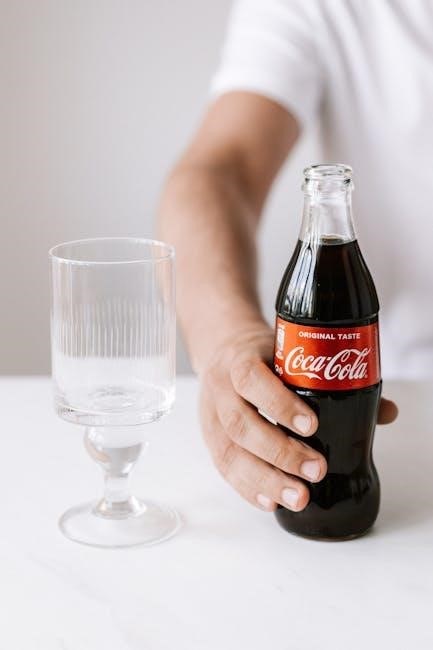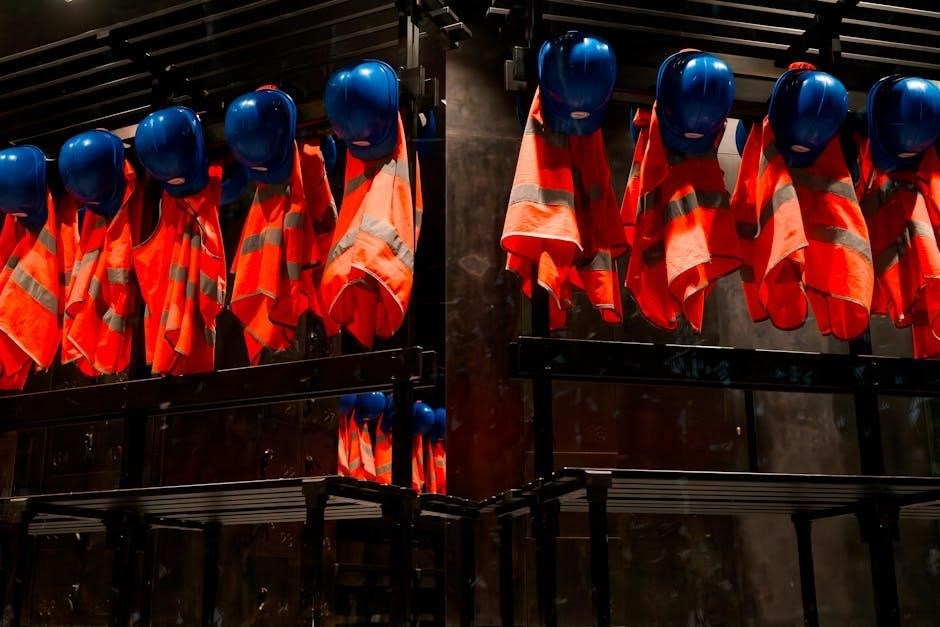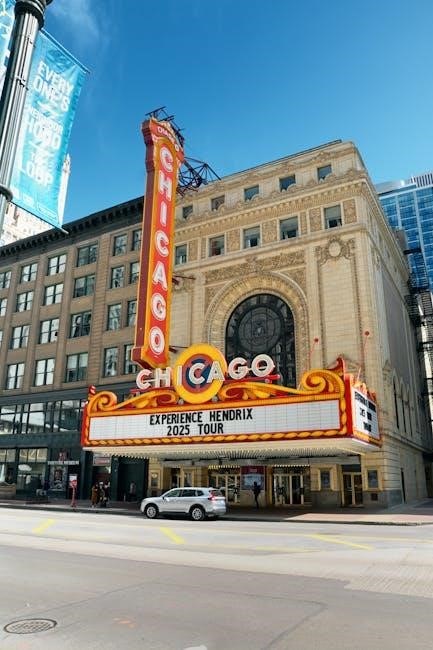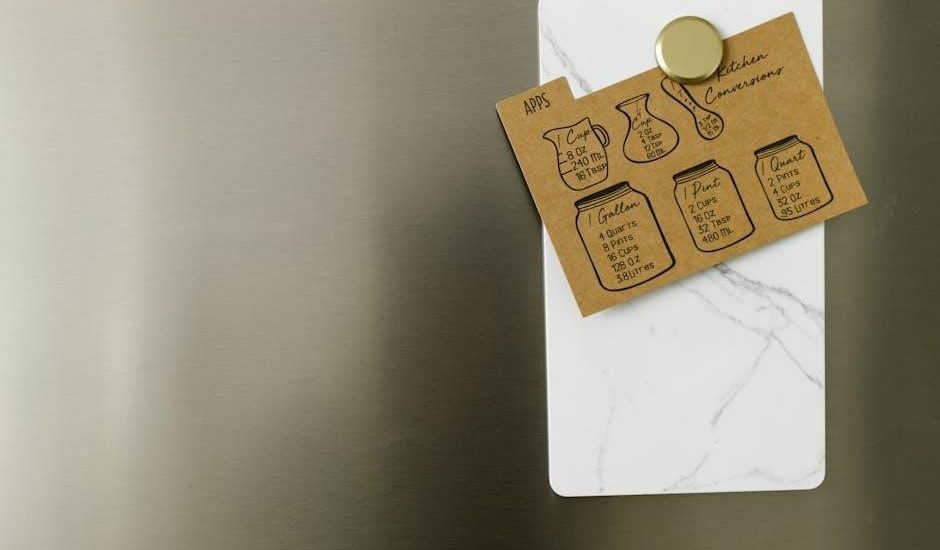The ANSI Z87.1 standard provides criteria for eye and face protection devices in occupational and educational settings, minimizing injuries from hazards like impacts, radiation, and chemicals.
Overview of the Standard
The ANSI Z87.1 standard establishes criteria for eye and face protection devices to prevent injuries from hazards like impacts, radiation, and liquid splashes in occupational and educational settings. It outlines testing protocols, marking requirements, and guidelines for selecting, using, and maintaining protectors. The standard applies to various environments, including workplaces and schools, ensuring devices meet safety specifications. It covers impact resistance, optical clarity, and radiation protection, providing a comprehensive framework for manufacturers and users. Compliance with ANSI Z87.1 is crucial for ensuring safety and meeting regulatory requirements, making it a vital resource for employers and safety professionals.
Importance of Eye and Face Protection
Eye and face protection is critical in preventing injuries from hazards like impacts, radiation, and liquid splashes. The ANSI Z87.1 standard emphasizes the importance of safeguarding vision, as eye injuries can lead to severe consequences, including vision loss. Protecting the face and eyes reduces workplace accidents, enhances safety culture, and ensures compliance with regulatory requirements. Proper protection devices, such as safety glasses, goggles, and faceshields, are essential for minimizing injury risks in hazardous environments. By adhering to the standard, employers and individuals can ensure optimal protection, maintaining productivity and quality of life. The standard’s guidelines are vital for preventing avoidable injuries and promoting workplace safety.
Historical Background of the Standard
The ANSI Z87.1 standard has evolved significantly since its inception. First introduced in 1989, it was developed to address growing concerns about workplace eye injuries. Over the years, the standard has undergone several revisions, with notable updates in 2003, 2010, and 2015, culminating in the current 2020 version. Each revision incorporated advancements in technology, new hazard assessments, and feedback from industry stakeholders. The standard’s historical development reflects a commitment to improving eye and face protection, ensuring it remains relevant and effective in safeguarding workers across various industries. Its evolution underscores the importance of adaptability in maintaining workplace safety standards.

Scope and Application of ANSI Z87.1
ANSI Z87.1 applies to occupational and educational environments, addressing hazards like impacts, radiation, and liquid splashes. It sets criteria for protectors to minimize injury risks in these settings.

Occupational Environments
ANSI Z87.1 applies to various occupational environments, including manufacturing, construction, and machinery operations, where eye and face protection is critical. The standard addresses hazards such as impact, radiation, and liquid splashes, ensuring protectors minimize injury risks. It is codified by OSHA, requiring employers to provide conforming safety eyewear. This ensures workers in high-risk settings have adequate protection, aligning with regulatory and safety best practices to prevent occupational injuries. The standard’s criteria are essential for safeguarding employees in diverse industrial and operational contexts.
Educational Environments
The ANSI Z87.1 standard also applies to educational environments, ensuring eye and face protection for students and staff in settings like laboratories, workshops, and classrooms. It addresses hazards such as chemical splashes, biological agents, and flying particles, which are common in educational labs. The standard requires protectors like goggles, faceshields, and safety glasses to meet specific criteria, ensuring they provide adequate protection during experiments or machinery use. Compliance with ANSI Z87.1 is crucial in educational institutions to safeguard individuals from preventable injuries, promoting a safer learning environment. This aligns with occupational safety practices, extending protection beyond industrial settings.
Types of Hazards Addressed
The ANSI Z87.1 standard addresses various hazards, including impact, non-ionizing radiation, and liquid splash exposures. It provides criteria to protect against flying particles, chemical splashes, and optical radiation, ensuring devices like safety glasses and goggles meet specific safety requirements. The standard also covers biological hazards, such as infectious droplets, particularly relevant in healthcare and laboratory settings. By addressing these risks, ANSI Z87.1 helps minimize eye and face injuries in both occupational and educational environments, ensuring comprehensive protection for users exposed to diverse hazards. Compliance with this standard is essential for safeguarding individuals in various workplaces and learning environments.

Key Updates in the 2020 Revision
The 2020 revision introduced enhanced testing protocols, new classification systems, and expanded requirements for face protection, ensuring better safety and clarity for users in various environments.
Enhanced Testing Protocols
The 2020 revision of ANSI Z87.1 introduced stricter testing protocols to ensure protectors meet rigorous safety standards. Impact resistance tests were refined to assess lens retention and frame integrity under various forces. Optical clarity requirements were updated to minimize distortions, ensuring sharp vision for users. Radiation protection standards were also enhanced, particularly for welding helmets, to block harmful UV and infrared emissions effectively. These updates aim to provide reliable protection across diverse occupational hazards, ensuring devices perform consistently in real-world scenarios. The revised protocols emphasize accuracy and durability, offering users enhanced confidence in their protective gear’s effectiveness.
New Classification Systems
The 2020 ANSI Z87.1 standard introduced new classification systems to better categorize eye and face protectors based on their protective capabilities. These systems define specific ratings for impact resistance, optical clarity, and protection against hazards like radiation and chemical splashes. The classifications help users select the most appropriate protectors for their work environments. This update ensures that devices are clearly labeled according to their performance, making it easier for employers and individuals to comply with safety requirements. The new systems also align with international standards, promoting consistency and safety across industries. This enhancement improves the overall effectiveness of eye and face protection devices.
Expanded Requirements for Face Protection
The 2020 ANSI Z87.1 standard includes expanded requirements for face protection, addressing a broader range of hazards such as chemical splashes, high-velocity impacts, and radiation exposure. These updates ensure that face protectors, including faceshields and welding helmets, meet stricter safety criteria. The standard now specifies enhanced testing protocols for durability, optical clarity, and consistency in protection across various environments. Additionally, it introduces more detailed guidelines for the design and materials used in face protection devices, ensuring they provide comprehensive coverage and comfort for users. These changes aim to reduce workplace injuries and improve compliance with safety regulations.

Types of Protectors Covered
The ANSI Z87.1 standard covers safety glasses, goggles, faceshields, and welding helmets, ensuring they meet specific safety requirements for eye and face protection in various environments.
Safety Glasses
Safety glasses are essential protective devices covered under the ANSI Z87.1 standard, designed to safeguard eyes from hazards like impact, radiation, and chemicals. They must meet rigorous testing criteria, including impact resistance and optical clarity, to ensure reliability. The standard differentiates between prescription and non-prescription lenses, both requiring adherence to specific thickness and material standards. Safety glasses are widely used in occupational and educational settings, providing critical protection without compromising visibility. Compliance with ANSI Z87.1 ensures they meet OSHA regulations, making them a cornerstone of workplace eye safety. Their durability and comfort are prioritized to encourage consistent use in hazardous environments.
Goggles
Goggles are specialized eye protection devices outlined in the ANSI Z87.1 standard, offering enhanced coverage and protection for severe hazards. They are designed to shield the eyes from impact, chemical splashes, and radiation, making them ideal for high-risk environments. The standard mandates rigorous testing, including impact resistance and leakage prevention, ensuring goggles provide reliable protection. Adjustable ventilation options are often included to prevent fogging, while maintaining a secure fit. Goggles are widely used in industries like manufacturing and healthcare, where comprehensive eye protection is critical. Compliance with ANSI Z87.1 ensures they meet OSHA requirements, making them a vital component of workplace safety protocols.
Faceshields
Faceshields are protective devices covered under the ANSI Z87.1 standard, designed to safeguard the face and eyes from hazards like impact, splashes, and radiation. They are typically worn in high-risk environments, such as manufacturing, construction, and healthcare. The standard requires faceshields to undergo rigorous testing for impact resistance and optical clarity. Adjustable headgear ensures a secure fit, while anti-fog coatings enhance visibility. Faceshields often complement safety glasses or goggles, providing extended protection. Compliance with ANSI Z87.1 ensures they meet OSHA regulations, making them essential for workplace safety in industries where facial protection is critical. Their durability and versatility make them a reliable choice for various occupational settings.
Welding Helmets
Welding helmets are specialized protective devices addressed in the ANSI Z87.1 standard, designed to safeguard eyes and faces during welding processes. They protect against hazards such as UV radiation, infrared rays, sparks, and slag. The standard specifies requirements for lens shade numbers, optical clarity, and impact resistance. Welding helmets must pass rigorous testing to ensure they meet safety criteria. They are essential in occupational environments like manufacturing and construction, where welding operations are common. Compliance with ANSI Z87.1 ensures these helmets provide reliable protection, adhering to OSHA regulations and industry safety standards. Their durability and advanced features make them indispensable for welders’ safety.
Testing and Certification
ANSI Z87.1 requires rigorous testing for impact resistance, optical clarity, and radiation protection to ensure protectors meet safety standards, guaranteeing reliability and compliance with industry regulations.
Impact Resistance Testing
Impact resistance testing is a critical component of the ANSI Z87.1 standard, ensuring protectors can withstand high-mass and low-mass impact forces. This testing involves dropping weighted objects onto the device to assess its ability to prevent penetration or cracking. High-mass tests simulate heavy impacts, while low-mass tests evaluate resistance to smaller, faster-moving objects. Protectors must maintain structural integrity and optical clarity post-impact. Failure to meet these criteria results in non-compliance, emphasizing the importance of rigorous testing to safeguard users in hazardous environments. This ensures reliable protection against workplace and educational setting risks.
Optical Clarity Requirements
Optical clarity is a fundamental aspect of the ANSI Z87.1 standard, ensuring that eye protectors maintain unobstructed vision. The standard specifies that lenses must meet strict refractive and prismatic requirements to prevent distortion. This ensures that users can perform tasks without visual interference. Optical clarity testing evaluates factors such as haze, luminous transmittance, and absence of defects like bubbles or scratches. Compliance guarantees that protectors do not compromise visual acuity, crucial for safety and productivity. These requirements apply to both prescription and non-prescription lenses, ensuring universal usability. Proper optical clarity is verified through rigorous testing, ensuring reliability and adherence to the standard’s guidelines.
Radiation Protection Standards
The ANSI Z87.1 standard includes specific requirements for radiation protection, particularly against non-ionizing radiation such as ultraviolet (UV) and infrared (IR) emissions. These standards are crucial for occupations like welding, where exposure to harmful radiation is common. The standard mandates that protectors, such as welding helmets and lenses, must provide adequate shielding based on the intensity and type of radiation. Testing includes evaluating optical density and visible light transmittance to ensure proper protection without compromising visibility. Compliance with these standards ensures that users are safeguarded from radiant energy hazards while maintaining functional vision in hazardous environments.

Compliance and Regulatory Requirements
ANSI Z87.1 is codified by OSHA, requiring employers to provide eye and face protection conforming to the standard. It ensures compliance with regulatory safety guidelines across industries.
OSHA Regulations
OSHA mandates employers to provide ANSI Z87.1-compliant eye and face protection, ensuring devices meet specific testing criteria for impact resistance, optical clarity, and radiation protection. This regulation applies to occupational settings where hazards like flying particles, chemicals, or radiation are present. Employers must select protectors based on job-specific risks, adhering to the standard’s guidelines. Compliance with OSHA regulations is critical to prevent eye injuries, which are among the most common workplace incidents. By enforcing ANSI Z87.1 standards, OSHA helps safeguard workers’ vision and facial safety, promoting a safer work environment across various industries.
Industry-Specific Compliance
The ANSI Z87.1 standard ensures compliance across various industries, addressing unique hazards in manufacturing, healthcare, and education. For instance, manufacturing environments require protection from flying particles, while healthcare settings focus on chemical splash and infectious droplet resistance. The standard provides tailored guidelines for each industry, ensuring eye and face protectors meet specific safety needs. Compliance is not one-size-fits-all; it is adapted to the risks inherent in each sector. This adaptability ensures consistent safety standards while addressing the diverse challenges faced by different industries, making ANSI Z87;1 a critical resource for workplace safety across multiple fields.
International Standards Alignment
The ANSI Z87.1 standard aligns with international safety standards, ensuring global recognition and harmonization. It is often referenced alongside ISO and EN standards, providing a consistent framework for eye and face protection worldwide. This alignment facilitates compliance for multinational organizations and manufacturers, ensuring products meet safety requirements across borders. By adhering to international norms, ANSI Z87.1 supports global safety initiatives, making it a key reference for industries operating internationally. This harmonization also aids in reducing trade barriers and ensures product safety and performance meet global expectations, reinforcing its role as a trusted standard worldwide.

Selection and Use of Protectors
The ANSI Z87.1 standard emphasizes selecting protectors based on specific hazards, ensuring they meet criteria for impact resistance, optical clarity, and radiation protection. Proper use and maintenance are critical.
Choosing the Right Protector
Selecting the appropriate eye and face protection requires assessing specific hazards, such as impact, radiation, or chemical exposure. The ANSI Z87.1 standard categorizes protectors based on their ability to address these risks. Safety glasses are suitable for general impact protection, while goggles provide enhanced coverage for chemical splashes. Faceshields and welding helmets are designed for broader facial protection, particularly in high-risk environments. Proper fit, comfort, and compliance with the standard’s testing criteria are essential to ensure effectiveness. Users must match the protector type to the hazard, considering factors like optical clarity and ventilation for optimal performance and safety.
Proper Fit and Comfort
Proper fit and comfort are critical for ensuring the effectiveness of eye and face protection devices. The ANSI Z87.1 standard emphasizes that protectors must be adjusted to fit the user securely, minimizing gaps that could expose the eyes or face to hazards. Comfort is equally important, as ill-fitting devices may cause discomfort, leading to distractions or improper use. Adjustable features, such as temple ends and nose pieces, help achieve a customized fit. Compatibility with other personal protective equipment (PPE) is also essential. Regular inspections should be conducted to ensure the protector remains in good condition and fits correctly, as poor fit can compromise safety and compliance with the standard.
Maintenance and Inspection
Regular maintenance and inspection of eye and face protection devices are essential to ensure their effectiveness. The ANSI Z87.1 standard recommends cleaning and sanitizing protectors with mild soap and water to prevent contamination. Scratches, cracks, or damage to lenses or frames should be inspected thoroughly, as they can compromise protection. Devices showing signs of wear or damage should be replaced promptly. Proper storage in a protective case when not in use is also advised to prevent accidental damage. Employers and users must adhere to these guidelines to maintain compliance and ensure the devices continue to provide adequate protection against hazards. Neglecting maintenance can lead to reduced performance and increased risk of injury.
Care and Maintenance
Proper care and maintenance ensure effectiveness and longevity. Clean with mild soap and water, avoiding harsh chemicals. Store in protective cases and replace damaged parts promptly.
Cleaning and Sanitizing
Proper cleaning and sanitizing are essential for maintaining the effectiveness of eye and face protection devices. Use mild soap and water to clean lenses and frames, avoiding abrasive materials that may scratch surfaces. Avoid harsh chemicals, as they can damage coatings or compromise the integrity of the protector. For sanitizing, follow the manufacturer’s guidelines, as some methods may void warranties or degrade materials. Regular cleaning prevents the buildup of contaminants that could impair vision or reduce protection. Always dry the device with a soft, lint-free cloth to prevent streaks and maintain optical clarity. Proper maintenance ensures continued safety and performance.
Storage Recommendations
Proper storage is crucial to maintain the integrity and performance of eye and face protection devices. Store protectors in a clean, dry environment, away from direct sunlight and extreme temperatures. Avoid exposing them to humidity or chemicals, as this may degrade materials. Use a protective case or pouch to prevent scratches and damage. Ensure the storage area is free from dust and contaminants. Do not store devices in vehicles for extended periods, as temperature fluctuations can cause warping or damage. Always follow the manufacturer’s storage guidelines to ensure the device remains in optimal condition for future use.
Replacement Guidelines
The ANSI Z87.1 standard outlines specific criteria for replacing eye and face protection devices. Protectors should be replaced immediately if damaged, scratched, or showing signs of wear. The standard recommends regular inspections to ensure optical clarity and structural integrity. Replace devices if they no longer meet the required safety standards or if they have been exposed to hazardous conditions beyond their design limits. Follow manufacturer guidelines for replacement intervals, especially for components like lenses or frames. Failure to replace worn or damaged protectors can compromise safety and increase the risk of injury. Adherence to these guidelines ensures ongoing protection and compliance with the standard.

Industry Applications
The ANSI Z87.1 standard applies to manufacturing, healthcare, education, and other industries, ensuring eye and face protection devices minimize injuries from occupational hazards.
Manufacturing and Construction
The ANSI Z87.1 standard is widely applied in manufacturing and construction industries to protect workers from hazards like flying particles, chemicals, and machinery. It ensures eye and face protectors meet rigorous safety criteria, including impact resistance and optical clarity. Employers in these sectors must provide ANSI-compliant gear to safeguard employees. The standard addresses specific risks associated with industrial environments, ensuring devices minimize injuries from operational hazards. Compliance with ANSI Z87.1 is crucial for maintaining workplace safety and adhering to regulatory requirements in these high-risk industries. Regular updates to the standard reflect evolving workplace hazards and technological advancements in protective equipment.
Healthcare and Laboratories
The ANSI Z87.1 standard plays a vital role in healthcare and laboratory settings, where workers face hazards like chemical splashes, biological agents, and infectious droplets. The standard ensures eye and face protectors provide adequate protection against these risks while maintaining optical clarity for precise tasks. Laboratories often require specialized goggles and faceshields that meet ANSI criteria for impact resistance and chemical resistance. In healthcare, particularly during pandemics, ANSI-compliant PPE is essential for safeguarding staff. The standard’s guidelines help prevent eye and face injuries, ensuring a safer environment for both patients and professionals in these critical fields.
Educational Institutions
The ANSI Z87.1 standard is crucial in educational institutions, particularly in science labs, workshops, and classrooms where hazardous materials or equipment are used. It ensures that students and staff are protected from eye and face injuries caused by chemical splashes, flying particles, or other hazards. The standard applies to educational environments, requiring protective eyewear that meets specific impact and optical clarity criteria. Compliance with ANSI Z87.1 helps schools maintain a safe learning environment while adhering to OSHA regulations. This standard is essential for preventing injuries and promoting safety in educational settings where hands-on activities involve potential risks.

Digital Access to the Standard
The ANSI Z87.1 standard is available in PDF format from the ANSI Webstore and other official sources. Some files are DRM-protected for copyright reasons.
PDF Format Availability
The ANSI Z87.1 standard is widely available in PDF format, enabling easy digital access for manufacturers, employers, and safety professionals. The PDF version can be downloaded from the official ANSI Webstore and other authorized sources. Some files are protected by Digital Rights Management (DRM) to ensure copyright compliance, allowing use on a single computer. This format ensures users have the most up-to-date guidelines for eye and face protection. Purchasing from official sources guarantees authenticity and compliance with the latest standards. Always verify the source to avoid unauthorized versions and ensure adherence to safety protocols. Digital access simplifies implementation and reference.
DRM Protection and Usage
Documents sold on the ANSI Webstore are in electronic Adobe Acrobat PDF format, with some protected by Digital Rights Management (DRM). DRM restricts file sharing, ensuring the PDF can only be opened on the computer it was downloaded to, preventing unauthorized distribution. This protection is implemented at the request of the copyright holder to maintain intellectual property integrity. While DRM enhances security, it may limit accessibility across multiple devices or networked servers. Users must adhere to these restrictions to comply with copyright laws and ensure the standard’s authenticity. DRM is a critical measure to safeguard the document’s content and prevent misuse. Always respect DRM guidelines when using the PDF.
Official Sources for Download
The ANSI Z87.1 standard PDF is available for download from the official ANSI Webstore and other authorized sources, ensuring authenticity and compliance. The document is provided in electronic Adobe Acrobat format, with some files protected by Digital Rights Management (DRM) to prevent unauthorized sharing. Users can download the PDF directly to their computer, but DRM restrictions may limit access to a single device. Official sources like the ANSI Webstore, ISEA, or authorized distributors guarantee the standard’s integrity and adherence to copyright laws. Always verify the source to avoid unauthorized or outdated versions of the standard.

Future Developments and Trends
Emerging technologies, such as advanced materials and smart eyewear, are expected to shape future updates to the ANSI Z87.1 standard, driven by industry feedback and evolving safety needs.
Emerging Technologies in Eye Protection
Advancements in eye protection include smart eyewear with integrated sensors for detecting UV exposure and chemical vapors. Anti-fog coatings and adaptive lenses improve visibility in varying conditions. Innovations like auto-tinting lenses and integrated wearable technology enhance user safety and convenience. These technologies align with the ANSI Z87.1 standard’s focus on minimizing hazards while maintaining optical clarity. As industry demands evolve, future updates to the standard may incorporate these emerging technologies, ensuring eye protection devices remain effective and adaptable to new workplace challenges.
Potential Updates to the Standard
Future updates to ANSI Z87.1 may include enhanced testing protocols for emerging hazards like nanoparticles and advanced chemical exposures. There could be new classifications for smart eyewear and integrated technologies. The standard might also expand requirements for anti-fogging and anti-scratch coatings, improving durability and visibility. Additionally, updates could address sustainability, such as recyclable materials, aligning with industry trends. These potential changes aim to keep the standard relevant, ensuring it continues to protect workers effectively in evolving occupational environments while maintaining its role as a cornerstone of eye and face protection guidelines.
Industry Feedback and Evolution
The ANSI Z87.1 standard evolves based on industry feedback, ensuring it remains relevant and effective. Manufacturers, safety organizations, and end-users contribute to updates, addressing emerging hazards and technologies. Recent revisions reflect advancements in materials science and workplace safety needs. The standard’s alignment with OSHA regulations and international standards underscores its adaptability. Feedback has also led to clearer guidelines for testing and certification, enhancing compliance and user confidence. This collaborative approach ensures the standard continues to protect workers effectively, adapting to new challenges and maintaining its critical role in workplace safety.





